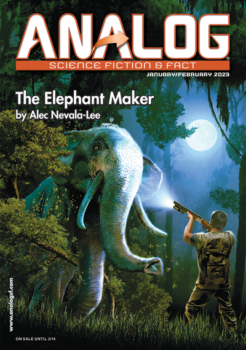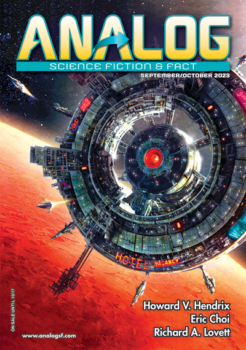
Analog announced the 2023 Analytical Laboratory Awards results in its July/August issue.
NOVELLAS (4.06)
- “Poison,” Frank Wu & Jay Werkheiser (6.56)
- “The Tinker and the Timestream,” Carolyn Ives Gilman (5.95)
- “Flying CARPET,” Rajnar Vajra (4.36)
- “To Fight the Colossus,” Adam-Troy Castro (3.95)
- “The Elephant-Maker,” Alec Nevala-Lee (3.54)
NOVELETTES (1.12)
- “The Deviltree,” Monalisa Foster (2.46)
- “Apollo in Retrograde,” Rosemary Claire Smith (2.26)
- “Didicosm,” Greg Egan (2.10)
- (TIE) “Recruit,” Stephen L. Burns (1.95)
(TIE) “The House on Infinity Street,” Allen M. Steele (1.95)
SHORT STORIES (0.29)
- “Blowout,” Wole Talabi (1.85)
- “Cornflower,” Victoria Navarra (1.74)
- “The Echo of a Will,” Marie Vibbert (1.28)
- “Second Sight,” Gray Rinehart (1.18)
- “An Infestation of Blue,” Wendy N. Wagner (1.13)
FACT ARTICLES (1.30)
- “The Science Behind ‘The Power of Apollo (16),’” Marianne J. Dyson (2.36)
- “Black Holes and the Human Future,” Howard V. Hendrix (2.00)
- (TIE) “Evolving Brainy Brains Takes More than Living on a Lucky Planet,” Christina De La Rocha (1.74)
(TIE) “The Science Behind Kepler’s Laws,” Jay Werkheiser (1.74) - “Another Way to the Stars,” Christopher MacLeod (1.44)
POETRY (3.59)
- “How to Conquer Gravity,” Mary Turzillo (3.95)
- “What Xenologists Read,” Mary Soon Lee (3.64)
- “Object Permanence,” Marissa Lingen (2.36)
- “The Observer,” Bruce Boston (2.10)
- “I Dreamt an Alien Was in Love with My Ex-Girlfriend,” Don Raymod (1.49)
COVER (2.28)
- May/June, by Tomislav Tikulin for “The Elephant Maker” (5.23)
- January/February, by Eldar Zakirov for “Aleyara’s Descent” (3.23)
- September/October, by Tomislav Tikulin (2.21)
HOW THE VOTE SCORING WORKS. In each category readers are asked to list their three favorite items, in descending order of preference. Each first place vote counts as three points, second place two, and third place one. The total number of points for each item is divided by the maximum it could have received (if everyone had ranked it 1) and multiplied by 10. The result is the score listed below, on a scale of 0 (nobody voted for it) to 10 (everybody ranked it first). In practice, scores run lower in categories with many entries than in those with only a few. For comparison, the number in parentheses at the head of each category is the average for that category.



[Thanks to Emily Hockaday for the story.]
Discover more from File 770
Subscribe to get the latest posts to your email.
